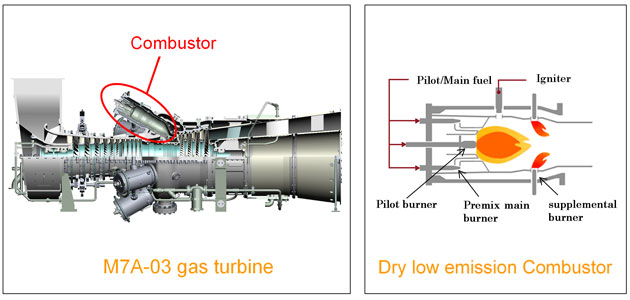New Gas Turbine Combustion Technology for Record Low NOx Emissions
Dec. 16, 2009
|
Tokyo, December 16, 2009 — Kawasaki Heavy Industries, Ltd. announced today that it has developed a new gas turbine combustion technology for its proprietary dry low emission (DLE) combustion system used mainly in natural gas-fired turbines. This breakthrough in premix combustion technology has enabled Kawasaki to build a gas turbine with the lowest NOx emissions ever. Kawasaki has successfully lowered the guaranteed maximum NOx emissions level of its 7 MW-class M7A-03 gas turbines from 25 ppm to an all time low of 15 ppm (converted at 15% O2). This is a milestone achievement for DLE combustion systems of this class. NOx is generated during the gas turbine fuel combustion process and released into the atmosphere. The amount of NOx generated largely depends on combustion temperature. DLE combustors employ a premix combustion method that minimizes combustion temperature without the use of injected water or steam by premixing the fuel with air. Since they provide an economical solution that significantly reduces NOx emissions, DLE combustors are employed in most gas turbines. The big problem with premix combustion, especially when used to lower NOx emissions, is that it is unstable. This had always been a major technological stumbling block to lowering DLE combustor NOx emissions. The key to success for Kawasaki lied in its focus on combining premix with supplemental burners. This focus is what enabled Kawasaki to develop and commercialize its proprietary DLE combustion systems with outstanding combustion stability. This latest technological breakthrough in lowering NOx emissions is built on a solid foundation of DLE combustor R&D. Kawasaki has leveraged the technological expertise it has gained over the years to upgrade the burners and develop a compact recombustion burner with enhanced mixing performance. Since stationary gas turbines emit NOx gasses that result in photochemical smog and acid rain, they are subject to strict regulations across the globe. An increasing number of local governments in the U.S. and Europe, where public awareness about preserving air quality is high, are implementing even stricter NOx emissions standards that lower the acceptable emissions level from 25 ppm to 15 ppm. These new regulations are seen as just the beginning of a growing trend. Kawasaki is working to develop new types of DLE combustion systems with a guaranteed maximum NOx emissions level of 15 ppm for its other major models and plans to launch them onto the market in the near future. NOx emissions regulations are likely to become even stiffer, with requirements for less than nine-ppm NOx emissions looming over the horizon. To meet these increasingly tougher NOx emissions standards, Kawasaki is moving ahead with R&D efforts that build on the low NOx combustion technology employed in its DLE combustion systems boasting a NOx emissions level of less than 15 ppm. Kawasaki is looking at new ways to put technology to work for the environment with more efficient products that leave a smaller footprint. |
|
 |





